
Features
Applications
Swine
Team tracks antibiotic resistance from swine farms to groundwater
March 8, 2008 by Diana Yates
The routine use of antibiotics in
swine production can have unintended consequences, with antibiotic
resistance genes sometimes leaking from waste lagoons into groundwater.
The routine use of antibiotics in swine production can have unintended consequences, with antibiotic resistance genes sometimes leaking from waste lagoons into groundwater.
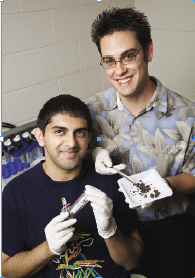 |
| Tony Yannarell, a postdoctoral research associate in the Institute for Genomic Biology (right), with undergraduate research assistant Shazan Ahmed, a junior in molecular and cellular biology, tracked the passage of tetracycline resistance genes from hog waste lagoons into groundwater wells at two Illinois swine facilities.
Photo By L. Brian Stauffer.
|
In a new study, researchers at the University of Illinois report that some genes found in hog waste lagoons are transferred – ‘like batons’ – from one bacterial species to another. The researchers found that this migration across species and into new environments sometimes dilutes – and sometimes amplifies – genes conferring antibiotic resistance.
The report, published in the August 2007 issue of Applied and Environmental Microbiology, tracks the passage of tetracycline resistance genes from hog waste lagoons into groundwater wells at two Illinois swine facilities. This is the first study to take a broad sample of tetracycline resistance genes in a landscape dominated by hog farming, says principal investigator Dr. Roderick I. Mackie. And it is one of the first to survey the genes directly rather than focusing on the organisms that host them. Dr. Mackie is a professor in the department of animal sciences at the University of Illinois and an affiliate of the Institute for Genomic Biology.
“At this stage, we’re not really concerned about who’s got these genes,” Dr. Mackie says. “If the genes are there, potentially they can get into the right organism at the right time and confer resistance to an antibiotic that’s being used to treat disease.”
Tetracycline is widely used in swine production. It is injected into the animals to treat or prevent disease and is often used as an additive in hog feed to boost the animals’ growth. Its near-continuous use in some hog farms promotes the evolution of tetracycline-resistant strains in the animals’ digestive tracts and manure.
The migration of antibiotic resistance from animal feeding operations into groundwater has broad implications for human and ecological health. There are roughly 238,000 animal feeding operations in the U.S., which collectively generate about 500 million tons of manure per year. Groundwater comprises about 40 percent of the public water supply and more than 97 percent of the drinking water used in rural areas.
 |
| Federal law mandates that animal facilities develop nutrient management plans to protect surface water and groundwater from fecal contamination. Most swine facilities hold the effluent in large, water-filled lagoons until it can be injected into the ground as fertilizer.
Photo courtesy of the Illinois State Geological Survey.
|
Federal law mandates that animal facilities develop nutrient management plans to protect surface water and groundwater from fecal contamination. Most swine facilities hold the effluent in large, water-filled lagoons until it can be injected into the ground as fertilizer. A change in the law in the late 1990s means new lagoons must be built with liners to prevent seepage. Swine facilities in operation prior to the new regulations are allowed to continue using unlined lagoons. However, some of these lagoons leak.
During the study, researchers extracted bacterial DNA from lagoons and groundwater wells at two study sites over a period of three years. They screened these samples for seven different tetracycline resistance genes. They found fluctuating levels of every one of the seven genes for which they screened in the lagoons. They also found that these genes were migrating from the lagoons to some of the groundwater wells.
It should be noted that many genes that confer antibiotic resistance occur naturally in the environment. Tetracycline is itself a bacterial
product, employed by Streptomyces bacteria long before humans discovered its usefulness.
In order to determine the origin of the tetracycline resistance genes found in the groundwater, the researchers conducted a genetic analysis of one gene family, tet(W), in samples from the lagoons and from groundwater wells below (downgradient of) and above (upgradient to) the lagoons. They found that the variants of tet(W) genes in the upgradient, environmental control wells were distinct from those of the lagoons, while the wells downgradient of the lagoons contained genes consistent with both the background levels and those in the lagoons.
“There’s a human impact on these sites that is superimposed on a natural signal,” says postdoctoral research assistant Anthony Yannarell, an author on the study.
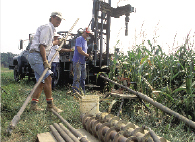 |
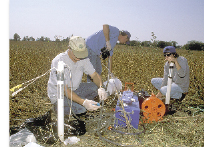
|
| Researchers drill a groundwater testing well at one of the farm sites. During the study, bacterial DNA was extracted from farm lagoons and test wells at two study sites over a period of three years.
Photo courtesy of the Illinois State Geological Survey.
|
Ivan Krapac (left), William Dey (center) and Steven Sargent, all with the Illinois State Geological Survey, extract a sample from a groundwater test well.
Photo courtesy of the Illinois State Geological Survey.
|
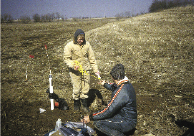 |
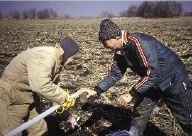 |
| Jean Suchomski (left), a graduate student with the University of Illinois, and Ivan Krapac, a geochemist with the Illinois State Geological Survey, extract samples from a groundwater test well.
Photo courtesy of the Illinois State Geological Survey.
|
All samples gathered were screened for seven different tetracycline resistance genes.
Photo courtesy of the Illinois State Geological Survey.
|
One of the two hog farms (Site A) was more impacted by resistance genes from the lagoon, due to its hydrogeology. The site included two layers of sand – at about two meters and eight meters below the surface – through which groundwater flowed. “Every time we looked in the lagoon, we saw all of the genes we were looking for,” Yannarell says. “At Site A, all the wells that were closest to the lagoon almost always had every gene. As you got further from the lagoon, you started to see genes dropping out.”
The resistance genes were present at much higher levels – “an order of magnitude higher,” say the authors – in the lagoon than in the contaminated wells. Most were diluted as they moved away from the lagoons in the groundwater.
There was one notable exception. A gene known as tet(C) was found at higher levels in some of the groundwater wells at Site A than in the lagoon. Its heightened presence was not consistent with background levels, indicating that something in the environment was amplifying this one gene, which had originated in the lagoon. Perhaps the gene had migrated to a new organism, Yannarell suggests, to find a host that was more suited to conditions in the groundwater.
“What we are seeing is that the genes can travel a lot further than the bacteria,” Dr. Mackie says. “It’s a matter of getting the DNA into the right organism. It’s a relay race.”
Other authors on the study are postdoctoral research assistant, S. Koike; Illinois State Geological Survey geochemist, I.G. Krapac; research assistant, H.D. Oliver; USDA Agricultural Research Service scientist and professor of crop sciences, Dr. J.C. Chee-Sanford; and visiting professor of animal sciences, Dr. R.I. Aminov.
Diana Yates is the Life Sciences Editor with the University of Illinois News Bureau. She can be reached at (217) 333-5802 or by e-mailing
diya@uiuc.edu.